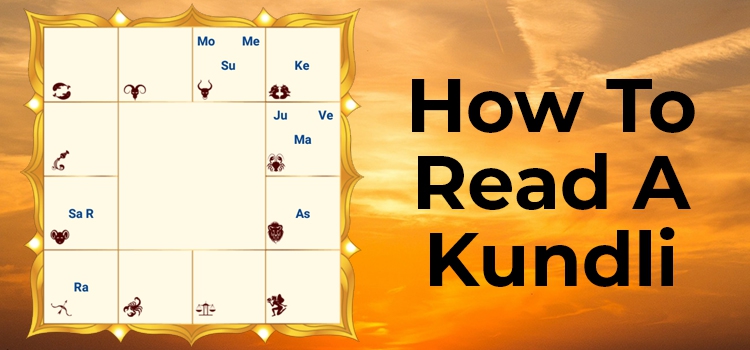How to Read a Kundali?
Kundali
Kundali is the natal chart, birth chart, or horoscope. It reflects the positioning of different planets in the celestial sphere at the moment and place of birth of a person. Hence, this remains unique to an individual. It is only based on such a Kundali that the ancient system of Vedic Astrology, recognized, respected, and widely accepted as a reliable predictive science, operates.
It is the reading or analysis of this Kundali that can reveal almost everything about any individual and his or her future. Hence correct astrological predictions depend entirely on the right drawing on the Kundali, plotting of the planets in it, and its precise reading.

Kundali reading can reveal particulars about a person in their entirety. It can tell about - his or her personality traits, physical features, mental makeup, talents, strengths, weaknesses, preferences, health, education, occupation, income, career or business progress, financial status, marriage, its longevity, harmony, and happiness, any illnesses, untoward happenings, and even the death of the native.
Kundali reading also plays a major role in all traditional marriages, when the horoscopes of the prospective bride and groom are matched for their compatibility and to see if the 2 can make a harmonious couple. It is only after ensuring that a satisfactory rapport exists between the 2 as per Kundali matching that our elders went ahead with their marital union.
Kundali Structure
The Kundali has a specialized structure consisting of 12 divisions, known as the Houses. These horoscopic Houses represent the 12 signs of the zodiac. The first House denotes the Rising Sign of the native, is known as the Lagna, or the Ascendant, and holds great importance for the person concerned. The other 11 Houses follow this Ascendant in the serial order and accordingly represent the different zodiac signs. The 9 planets are plotted in these 12 Houses of the Kundali, as they are found in the sky, at the time and place of birth of the person.
Each of the 12 Kundali Houses is unique and has its own significance.
Horoscopic Houses
The First House, the Ascendant, denotes the native’s personality, physical features, and characteristics. The Second House is the Dhana and Kutumba Sthana, which denotes wealth, family, and speech; Third, Sahodhara and Dhairiya Sthana indicates courage, younger siblings, and communication; Fourth, Sukha Sthana represents comforts, mother, properties, and vehicles; Fifth, Purva Punya Sthana stands for children, past life actions, love, and fine arts; Sixth, the Shatru, Runa, Roga Sthana denotes diseases, debts, enemies, and court cases; Seventh, Kalathra Sthana is the House of marriage, spouse, relationships, and business; Eighth is the Ayur Sthana that indicates longevity, unexpected happenings, and death; Ninth is the Bagya and Pitru Sthana, standing for fortunes, spirituality, father, ancestors, teacher, and higher education; Tenth, the Karma Sthana, is the House of Karma, the actions, occupation, status, and reputation; Eleventh is Laabha Sthana, the House of financial gains, benefits, fulfillment of ambitions, and older siblings; and the Twelfth House is the Viraya Sthana denoting losses, expenditure, and enlightenment.
Each of these 12 Houses will coincide with one of the 12 zodiac signs – Aries, Taurus, Gemini, Cancer, Leo, Virgo, Libra, Scorpio, Sagittarius, Capricorn, Aquarius, and Pisces. These signs have their own individual characteristics and are ruled by different planets.
Planets
The ancient system of Vedic Astrology recognizes 9 planets, which are the Sun, Moon, Mars, Mercury, Jupiter, Venus, Saturn, Rahu, and Ketu. Of these, Rahu and Ketu are only the Northern and Southern lunar nodes, the points of intersection of the solar and lunar orbits in space. Hence, these do not have a physical existence and are called Chaya Graha, the Shadow Planets. Of the 9 planets, Mercury, Jupiter, Venus, and waxing Moon are regarded benefic, while the Sun, Mars, Saturn, Rahu, Ketu, and waning Moon, malefic.
While Sun, the king of the planets and the source of life, energy, and light, denotes father, generosity, and fame; the Moon represents the mind; Mars, land, courage, and aggression; Mercury, intellect, skills, and communication; Jupiter, wealth, children, higher education, and wisdom; Venus, beauty, love, fine arts, and marriage; Saturn, profession, results of actions, and misfortune; Rahu, worldly possessions, foreigners, and failures; and Ketu denotes sufferings and spiritual wisdom.
Kundali Reading
All these particulars about the Kundali of an individual, like - the Ascendant, its planetary Lord, the zodiac signs with which the various Houses of the Kundali coincide, their planetary Lords, where these Lords are placed, which planet is placed in which House and whether it is benefic or malefic, which planets aspect, that is, casts its glance on which House and planet, the transits of planets and their stay in any particular horoscopic House, etc. – can reveal a great many details about the person, his or her life, fortunes, and future.
Experts in the field of astrology take all these into account, do calculations, make assessments, and come out with precise predictions about the person. Kundali reading is thus a fine art that can help people virtually peep into their future.
Rasi Calculator
The Moon sign is known as Rasi, which is made up of a set of Natchathirams, the stars. The Rasi calculator or Rasi finder is a simple self-operated system through which a person can know about his or her Janma Natchathiram, the birth star, and Rasi by providing the birth details. Also known as the Nakshatra calculator, this facility is available in many languages, including Tamil. So, Tamil-speaking people can also use this to learn about their Rasi Natchathiram in Tamil and get benefitted.



















